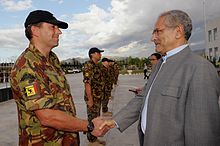International Stabilization Force
The International Stabilization Force ISF ( German International Stabilization Force ) was a multinational military intervention force in East Timor , under the leadership of Australia . Because of the riots of 2006 , in which at least 37 people died and 155,000 people were forced to flee the East Timorese government asked for international assistance to restore order. The first ISF units landed at Dili airport on May 25, 2006 . The mission ended on December 31, 2012. On March 25, 2013, the offices and warehouse were handed over to East Timor.
General

In addition to Australia, New Zealand and at times Malaysia and Portugal had also sent troops to East Timor. Initially over 3,000 soldiers were deployed, but after the United Nations dispatched an international police mission ( UNMIT ) at the end of August 2006 and the situation calmed down, the number of troops was reduced.
The ISF and UNMIT jointly ensured public order and helped to rebuild the East Timorese security forces. An important task of both was to ensure the reasonably peaceful course of the presidential and parliamentary elections in 2007 . However, it was important to Australia that the ISF remained under their and not under UN leadership.
The ISF's attempt to capture the fugitive leader of the soldiers who rebelled in 2006, Alfredo Reinado, was unsuccessful . An attempt to gain access in Same failed despite the deployment of an Australian special force and helicopter. Reinado was later killed in an attack on the East Timorese government on February 11, 2008 . The rebel movement then collapsed in the weeks that followed.
The troops were gradually reduced due to the progress made in stabilizing the country, so it was decided to say goodbye to the foreign security forces after the 2012 presidential and parliamentary elections .
Composition of the force

In February 2008, after the attack on February 11, 2008, Australia increased its troops from 800 to 1,000 men. At the end of October 2008 the ISF still consisted of around 1,000 men. Australia provided soldiers from the ANZAC Battle Group of the 1st Battalion of the Royal Australian Regiment from Townsville . In addition there were army aviation units , logistics, military police and pioneers. In October 2009 the Australian contingent only consisted of 650 men. New Zealand provided 155 soldiers in December 2009. These include an Infantry Rifle Company under the ANZAC Battle Group and two Iroquois helicopters with 32 members of No 3 Squadron of the Royal New Zealand Air Force .
In 2010 the force was reduced to 400 Australian and 75 New Zealand soldiers.
List of commanders
| No. | Surname | Beginning of the appointment | End of appointment |
|---|---|---|---|
| 10 | Colonel Luke Foster | July 3, 2011 | --- |
| 9 | Colonel Michael Reilly | October 9, 2011 | July 3, 2011 |
| 8th | Colonel Simon Stuart | February 25, 2010 | October 9, 2011 |
| 7th | Commodore Stuart Mayer | October 24, 2009 | February 25, 2010 |
| 6th | Brigadier Bill Sowry | January 19, 2009 | October 23, 2009 |
| 5 | Brigadier Mark Holmes | July 31, 2008 | January 19, 2009 |
| 4th | Brigadier James Baker | January 29, 2008 | July 31, 2008 |
| 3 | Brigadier John Hutcheson | August 2, 2007 | January 29, 2008 |
| 2 | Brigadier Mal Rerden | October 2006 | August 2, 2007 |
| 1 | Brigadier Michael Slater | May 25, 2006 | October 2006 |
See also
Individual evidence
- ^ East Timorese government website: ISF returns aerodrome to Ministry of Justice , accessed April 19, 2013
- ↑ a b The Age, December 24, 2010, East Timor wants Diggers to leave
- ↑ Australia Network: East Timor discusses future role of Australian soldiers , October 24, 2009


